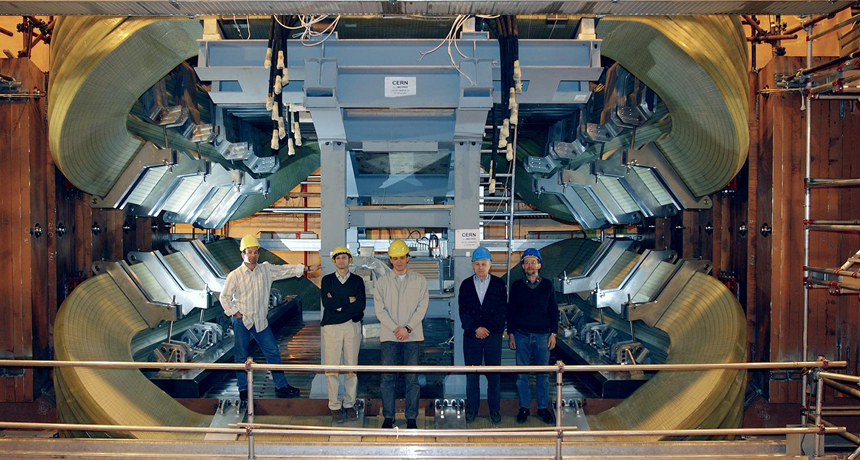Quark quartet forms exotic particle
Existence of strange stuff confirmed in data from giant particle collider

This giant magnet is part of the LHCb experiment at the Large Hadron Collider. Data from the experiment were used to confirm the existence of an exotic particle made from four quarks.
CERN
Particles called quarks are important building blocks of matter. They’re usually found stuck together as triples or pairs to form bigger particles like the protons and neutrons that make up the core of an atom. Now scientists say quarks come in quartets, too. A new study confirms the existence of a strange kind of particle made from a cluster of four quarks.
More than 10 years ago, researchers suggested that such a foursome could exist. But they lacked the data needed to confirm this. Now scientists studying data from the Large Hadron Collider in Europe at last report strong evidence the particle is real.
By showing that such particles exist, “we are automatically proving that four-quark states [of matter] exist,” Tomasz Skwarnicki told Science News. He is a physicist, a scientist who studies energy and matter, at Syracuse University in New York. Skwarnicki and his colleagues posted their findings online April 7 at arXiv.org. It’s a website for sharing physics papers.
Six types of quarks are found in ordinary matter. But none exists alone. Quarks always are found bundled — essentially glued together — by particles called gluons. Particles made of quarks are called hadrons. Examples of hadrons include protons and neutrons, each made from three quarks.
In 2003, scientists at the Belle particle collider in Japan found a hadron that they thought was made of four quarks. (A collider accelerates particles up to close to the speed of light, then smashes them together.) The particle that came out of the Belle collisions was named X(3872). This particle didn’t fit the usual rule that hadrons be made from two or three quarks, but scientists couldn’t prove X(3872) was made of four quarks. Then in 2008, scientists using the same collider found another particle that might have four quarks. Named Z(4430), it had as much mass as four protons, they estimated.
Z(4430), too, proved controversial. Many physicists questioned whether it was real. The new paper finally offers convincing evidence that Z(4430) indeed has four quarks at its heart.
The experiment “definitively confirmed Belle’s claim that this particle exists,” Matthew Shepherd told Science News. A physicist at Indiana University Bloomington, he did not work on the new study.
Skwarnicki and his colleagues found the particle by combing through data from the Large Hadron Collider (LHC). This giant, underground particle smasher straddles the border between Switzerland and France. Experiments at the LHC in 2012 turned up the Higgs boson — an important but different type of elusive particle.
For their quark-quartet discovery, Skwarnicki and his team studied more than 25,000 smash-ups between hadrons. When particles collide, they break into smaller bits. These are made of quarks, gluons and more — a whole zoo of subatomic building blocks. Those building blocks can then link to form new particles. The physicists found overwhelming evidence that four-quark particles formed briefly in the violent aftermath of the collisions. And, just as the scientists had predicted in 2008, the four-quark particle had about as much mass as four protons.
Four-quark particles do not exist naturally. They form only in high-energy experiments, such as those at LHC and the Belle particle collider. However, Skwarnicki suspects that quark quartets may have formed in the high-energy environment of the early universe. His next step, he says, is to figure out how four quarks unite to make those bigger particles.
Shepherd says he’s hopeful that scientists will soon know more about this strange matter. “There’s so much activity going on right now,” he told Science News. “The prospects for resolving this soon are good.”
Power Words
atom The basic unit of a chemical element. Atoms are made up of a dense nucleus that contains positively charged protons and neutrally charged neutrons. The nucleus is orbited by a cloud of negatively charged electrons.
collider (in physics) Sometimes called an “atom smasher,” it is a type of particle accelerator that speeds up charged particles (ions) through an electric field inside a hollow tube or racetrack-shaped structure. Eventually the device will direct the ions to collide with an unmoving target or another beam of moving particles. The ensuing collisions force some particles to interact — and break apart or briefly bind. Some of smashed particle also may recombine, creating new particles. The biggest of these machines are used to hunt for the basic building blocks of all nature.
gluon A subatomic particle believed to bind other particles together.
hadron One of a group of particles that are made up of other, smaller particles — quarks — held together by a particular kind of force. The protons and neutrons found in the nucleus of atoms are hadrons.
neutron A subatomic particle carrying no electric charge that is one of the basic pieces of matter. Neutrons belong to the family of particles known as hadrons (see above).
physics The scientific study of the nature and properties of matter and energy.
proton A subatomic particle that is one of the basic building blocks of the atoms that make up matter. Protons belong to the family of particles known as hadrons.
quarks A family of subatomic particles that each carries a fractional electric charge. Quarks are building blocks of particles called hadrons. They come in types, or “flavors,” known as: up, down, strange, charm, top and bottom.
subatomic Anything smaller than an atom, which is the smallest bit of matter that has all the properties of whatever chemical element it is (like hydrogen, iron or calcium).







